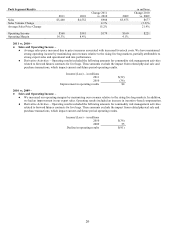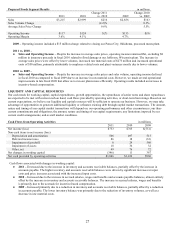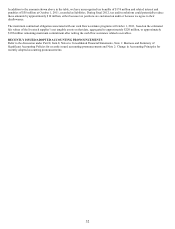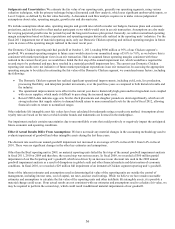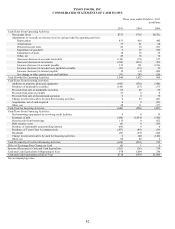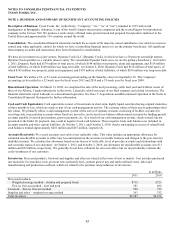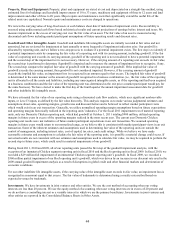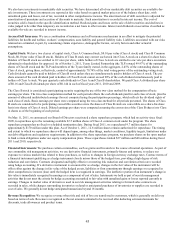Tyson Foods 2011 Annual Report Download - page 36
Download and view the complete annual report
Please find page 36 of the 2011 Tyson Foods annual report below. You can navigate through the pages in the report by either clicking on the pages listed below, or by using the keyword search tool below to find specific information within the annual report.36
Judgments and Uncertainties: We estimate the fair value of our reporting units, generally our operating segments, using various
valuation techniques, with the primary technique being a discounted cash flow analysis, which uses significant unobservable inputs, or
Level 3 inputs, as defined by the fair value hierarchy. A discounted cash flow analysis requires us to make various judgmental
assumptions about sales, operating margins, growth rates and discount rates.
We include assumptions about sales, operating margins and growth rates which consider our budgets, business plans and economic
projections, and are believed to reflect market participant views which would exist in an exit transaction. Assumptions are also made
for varying perpetual growth rates for periods beyond the long-term business plan period. Generally, we utilize normalized operating
margin assumptions based on future expectations and operating margins historically realized in the reporting units’ industries. For the
fiscal 2011 impairment test of material reporting units, only our Domestic Chicken reporting unit utilized operating margins in future
years in excess of the operating margin realized in the most recent year.
Our Domestic Chicken reporting unit had goodwill at October 1, 2011, totaling $900 million or 95% of our Chicken segment’s
goodwill. We assumed operating margins in future years would return to our normalized range of 5.0% to 7.0%, as we believe this is
consistent with market participant views in an exit transaction. Had we assumed future operating margins consistent with those
realized in the current fiscal year, we would have failed the first step of the annual impairment test, which would have required the
second step to be performed and may have resulted in a material goodwill impairment loss. The current year Domestic Chicken
reporting unit results were not indicative of future market participant expectations in an exit transaction. In assessing the appropriate
operating margins to be utilized in estimating the fair value of the Domestic Chicken segment, we considered many factors, including
the following:
x The Domestic Chicken segment has realized significant operational improvements, including yield, mix, live production,
processing flexibility, and interplant product movements, over the past three years as compared to both historical results and
the industry.
x The operational improvements were offset in the current year due to historically high grain and feed ingredient costs coupled
with excess supplies, which made it difficult to pass along the increased input costs.
x Recent USDA data indicates eggs sets, broiler chick placements and slaughter pounds are down significantly, which are all
strong indicators that supply relative to demand should return to more normalized levels by the end of fiscal 2012, allowing
financial results to return to normalized ranges.
Other indefinite life intangible asset fair values have been calculated for trademarks using a royalty rate method. Assumptions about
royalty rates are based on the rates at which similar brands and trademarks are licensed in the marketplace.
Our impairment analysis contains uncertainties due to uncontrollable events that could positively or negatively impact the anticipated
future economic and operating conditions.
Effect if Actual Results Differ From Assumptions: We have not made any material changes in the accounting methodology used to
evaluate impairment of goodwill and other intangible assets during the last three years.
The discount rate used in our annual goodwill impairment test increased to an average of 8.8% in fiscal 2011 from 8.4% in fiscal
2010. There were no significant changes in the other key estimates and assumptions.
Other than the Beef reporting unit in 2009, no material reporting units failed the first step of the annual goodwill impairment analysis
in fiscal 2011, 2010 or 2009 and therefore, the second step was not necessary. In fiscal 2009, we recorded a $560 million partial
impairment of our Beef reporting unit’s goodwill, which was driven by an increase in our discount rate used in the 2009 annual
goodwill impairment analysis as a result of disruptions in global credit and other financial markets and deterioration of economic
conditions. In fiscal 2010, we recorded a $29 million full impairment of an immaterial Chicken segment reporting unit’s goodwill.
Some of the inherent estimates and assumptions used in determining fair value of the reporting units are outside the control of
management, including interest rates, cost of capital, tax rates, and our credit ratings. While we believe we have made reasonable
estimates and assumptions to calculate the fair value of the reporting units and other indefinite life intangible assets, it is possible a
material change could occur. If our actual results are not consistent with our estimates and assumptions used to calculate fair value, we
may be required to perform the second step, which could result in additional material impairments of our goodwill.


